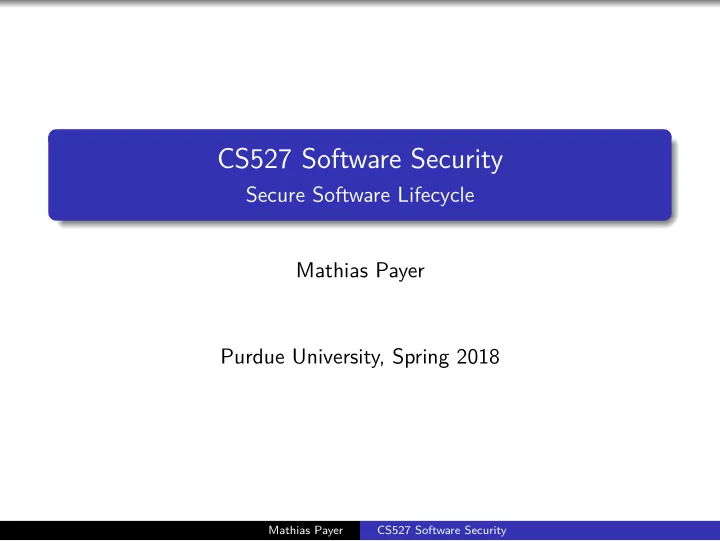

CS527 Software Security Secure Software Lifecycle Mathias Payer Purdue University, Spring 2018 Mathias Payer CS527 Software Security
Software liveliness Software is not a one-shot effort Software development, production, and maintenance are cost/labor intensive Software life-time can outlive hardware Mathias Payer CS527 Software Security
Example: Ubuntu security evolution Figure 1: Mathias Payer CS527 Software Security
Example: Ubuntu security evolution Configuration Subsystems Mandatory Access Control (MAC) Filesystem encryption Trusted Platform Module Userspace Hardening: Kernel Hardening See https://wiki.ubuntu.com/Security/Features Mathias Payer CS527 Software Security
Example: Ubuntu security evolution Configuration: No Open Ports; Password hashing; SYN cookies; Automatic security updates; Kernel Livepatches Mathias Payer CS527 Software Security
Example: Ubuntu security evolution Subsystems: Filesystem Capabilities; Configurable Firewall; Cloud PRNG seed; PR_SET_SECCOMP Mathias Payer CS527 Software Security
Example: Ubuntu security evolution Mandatory Access Control (MAC): AppArmor; SELinux; SMACK Mathias Payer CS527 Software Security
Example: Ubuntu security evolution Filesystem encryption: Encrypted LVM; eCryptfs Mathias Payer CS527 Software Security
Example: Ubuntu security evolution Trusted Platform Module Mathias Payer CS527 Software Security
Example: Ubuntu security evolution Userspace Hardening (1/2): Stack Protector; Heap Protector; Pointer Obfuscation; Address Space Layout Randomisation (ASLR): Stack ASLR; Libs/mmap ASLR; Exec ASLR; brk ASLR; VDSO ASLR Mathias Payer CS527 Software Security
Example: Ubuntu security evolution Userspace Hardening (2/2): Built as PIE; Built with Fortify Source; Built with RELRO; Built with BIND_NOW; Non-Executable Memory; /proc/$pid/maps protection; Symlink restrictions; Hardlink restrictions; ptrace scope Mathias Payer CS527 Software Security
Example: Ubuntu security evolution Kernel Hardening (1/2): 0-address protection; /dev/mem protection; /dev/kmem disabled; Block module loading; Read-only data sections; Stack protector; Module RO/NX; Kernel Address Display Restriction; Kernel Address Space Layout Randomisation Mathias Payer CS527 Software Security
Example: Ubuntu security evolution Kernel Hardening (2/2): Blacklist Rare Protocols; Syscall Filtering; dmesg restrictions; Block kexec; UEFI Secure Boot (amd64) Mathias Payer CS527 Software Security
Secure SE versus SE What is the difference between software engineering and secure software engineering? If we have secure SE, why not also {reliable | robust | resilient | reproducible | trusted | verifiable | . . . } SE? Mathias Payer CS527 Software Security
Secure SE versus SE Software engineering (SE) is concerned with developing and maintaining software systems that behave reliably and efficiently, are affordable to develop and maintain, and satisfy all the requirements that customers have defined for them. It is important because of the impact of large, expensive software systems and the role of software in safety-critical applications. It integrates significant mathematics, computer science and practices whose origins are in engineering. See http://computingcareers.acm.org/?page_id=12 Mathias Payer CS527 Software Security
Why do we need secure SE? Prevent loss/corruption of data Prevent unauthorized access to data Prevent unauthorized computation Prevent escalation of privileges Prevent downtime of resources Note, this is not a SE class. We will not focus on waterfall, incremental, extreme, spiral, agile, or continuous integration/continuous delivery. Examples follow the traditional SE approach, leaving it up to you to generalize to your favorite SE approach. Mathias Payer CS527 Software Security
Secure SE lifecycle Requirements/Specification Design Implementation Testing Updates and patching Mathias Payer CS527 Software Security
Requirements/Specification Regular SE requirement specification plus Security specification Asset identification Assess environment Use cases and abuse cases Mathias Payer CS527 Software Security
Design Regular SE design plus Threat modeling Security design Execution environment and actors Design review Design documentation (prose) Mathias Payer CS527 Software Security
Implementation Regular SE implementation plus Source code repository/version control Coding standards (assertions, documentation) Source code review process Mathias Payer CS527 Software Security
Testing Regular SE testing plus Security test plans Automatic testing Fuzzing Symbolic exceution Formal verification Red team testing Continuous integration testing (Jenkins, Travis, etc) Mathias Payer CS527 Software Security
Updates and patching Dedicated security response team Continuous process: new features, security issues Regression testing Secure update deployment Mathias Payer CS527 Software Security
Summary Software lives and evolves Security must be first class citizen Secure Requirements/specification Security-aware Design (Threats?) Secure Implementation (Reviews?) Testing (Read team, fuzzing, unit) Updates and patching Example: Ubuntu security features Mathias Payer CS527 Software Security
Recommend
More recommend